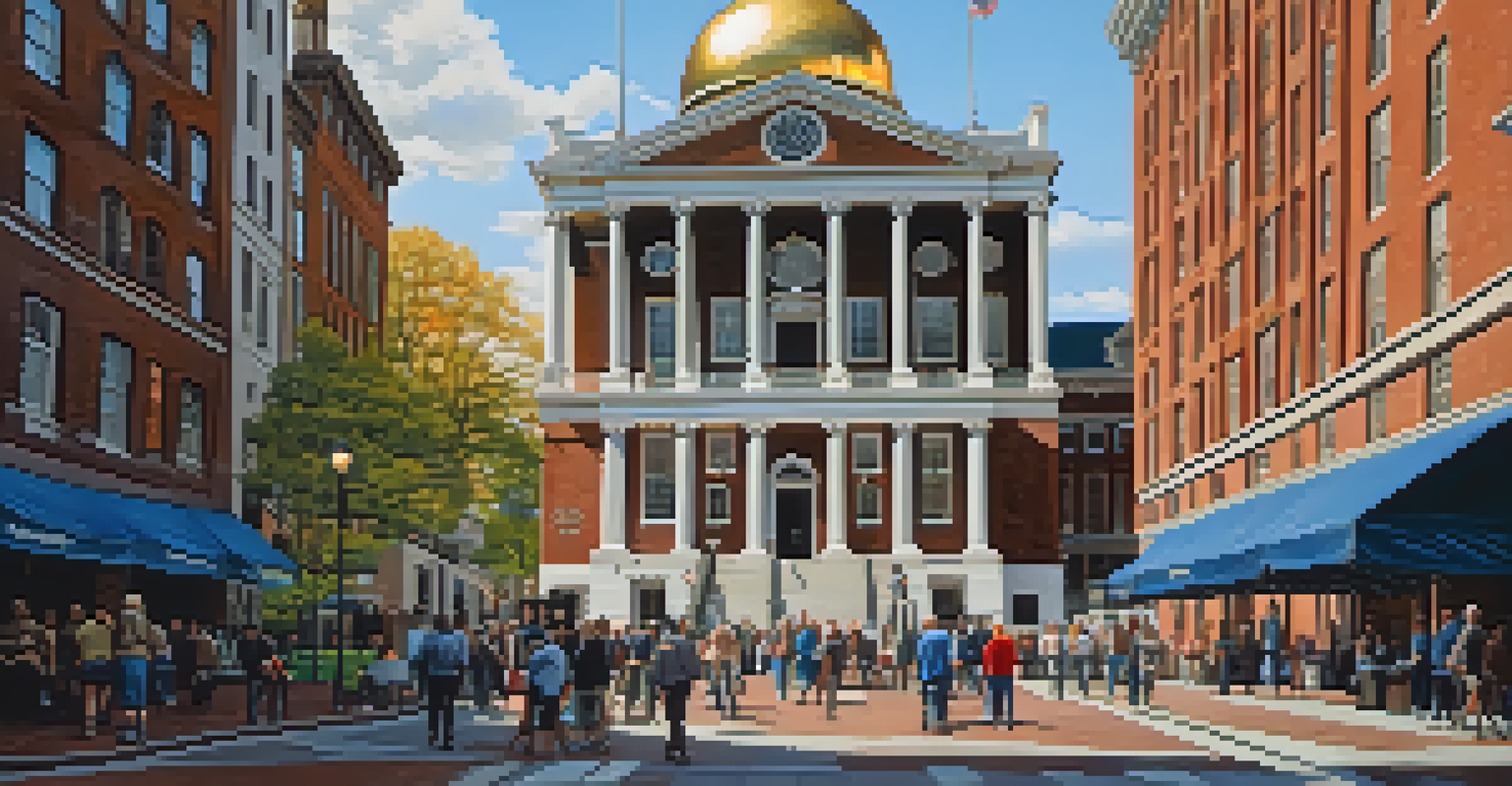Walking the Freedom Trail: Boston's Revolutionary Heritage

An Overview of the Freedom Trail: A Walk Through History
The Freedom Trail is more than just a path; it's a journey through America's revolutionary past. Stretching 2.5 miles, this iconic trail weaves through Boston, connecting 16 historical sites that tell the story of the nation's fight for independence. As you walk, you'll find yourself stepping into the shoes of the patriots who shaped the future of the United States.
History is not a burden on the memory but an illumination of the soul.
Each site along the trail offers a unique glimpse into the events that unfolded in the 18th century. From the Boston Common, the oldest public park in the country, to the historic North End, the trail invites you to explore landmarks that played pivotal roles in the American Revolution. It's like walking through a living museum, where history comes alive with every step.
Related Resource
Whether you're a history buff or a casual traveler, the Freedom Trail offers something for everyone. The combination of beautiful scenery and rich historical context makes this walk not only educational but also enjoyable. So grab your walking shoes and get ready to delve into Boston's revolutionary heritage!
Starting Point: Boston Common and the Park's Significance
Your journey begins at Boston Common, a sprawling green space that dates back to 1634. As the oldest public park in America, it has served many purposes over the centuries, from a common grazing area to a gathering spot for protests and celebrations. Standing at the park's entrance, you can almost hear the echoes of history as you envision the crowds that once gathered here.

The Common is not just a starting point; it sets the tone for your entire experience on the Freedom Trail. With its serene landscapes and historical statues, the park invites reflection on the sacrifices made for freedom. It's the perfect place to gather your thoughts before embarking on a walk through revolutionary history.
Explore Boston's Rich History
The Freedom Trail offers a captivating journey through 16 significant historical sites that narrate the story of America's fight for independence.
As you stroll through Boston Common, take a moment to appreciate its beauty and significance. This park has witnessed countless events that shaped the nation, making it a fitting beginning to your exploration. Make sure to snap a few photos; after all, this is where your adventure through Boston's past officially begins!
Key Historical Sites: Discovering the Trail's Highlights
The Freedom Trail is home to numerous historical sites, each with its own story to tell. Key highlights include the Massachusetts State House, with its iconic golden dome, and the Old State House, where the Boston Massacre was famously debated. These sites not only showcase architectural beauty but also serve as reminders of the spirited debates that fueled the revolutionary movement.
The more you know about the past, the better prepared you are for the future.
Another must-see is Paul Revere's House, the oldest remaining structure in downtown Boston. This charming home offers a glimpse into the life of one of America's most famous patriots. Imagine the late-night ride that made Revere a household name as you walk through the very rooms where he lived and planned his legendary midnight ride.
Related Resource
Additionally, the sites along the trail are thoughtfully connected, making it easy to navigate from one to the next. Each location is marked with a red brick or painted line, guiding you through the city while immersing you in its revolutionary past. It's a self-guided tour that allows you to set your own pace and fully soak in the history around you.
The Role of Guided Tours in Enhancing Your Experience
While walking the Freedom Trail on your own is enjoyable, guided tours can enhance your experience significantly. Knowledgeable guides bring history to life with engaging stories, anecdotes, and facts that might not be found in guidebooks. Their passion for the subject can ignite your interest, making the history feel relevant and personal.
Guided tours often include stops at lesser-known sites that are easy to overlook. For example, you might discover the hidden history of the African Meeting House, the oldest black church in the United States, and learn about its role in the abolitionist movement. These stories provide a fuller picture of Boston's diverse history and the many voices that contributed to the fight for freedom.
Guided Tours Enhance Experience
Joining a guided tour along the Freedom Trail provides deeper insights and engaging stories that enrich your understanding of the revolutionary past.
Whether you choose a historical reenactment, a ghost tour, or a family-friendly option, guided tours offer unique perspectives that enrich your journey. They can also help you navigate the trail efficiently, ensuring you don’t miss out on any significant landmarks. So consider joining a tour to gain deeper insights into Boston's revolutionary heritage.
Exploring Boston's Revolutionary Figures Along the Trail
As you follow the Freedom Trail, you'll encounter the stories of key figures who played pivotal roles in the American Revolution. From Samuel Adams, a master of persuasion, to John Hancock, known for his bold signature on the Declaration of Independence, these individuals helped shape the course of history. Their legacies are woven into the fabric of the sites you'll visit.
Consider visiting the Old South Meeting House, where Adams and his fellow patriots rallied support against British rule. This historic church was the birthplace of the Boston Tea Party, and standing in the same space where these revolutionary conversations took place can be a powerful experience. It’s a testament to the power of community and collaboration in effecting change.
Related Resource
Understanding the motivations and actions of these figures adds depth to your journey. Their stories reflect the struggles and triumphs of a nation fighting for its identity. By recognizing the human experiences behind the historical events, you’ll leave with not just facts, but a connection to the spirit of resilience that defined the revolution.
The Culinary Side of the Freedom Trail: Taste of History
Walking the Freedom Trail isn't just a feast for the mind; it's also an opportunity to indulge your taste buds. Along the route, you'll find a variety of dining options that reflect Boston's rich culinary scene. From classic clam chowder to delicious lobster rolls, there's something to satisfy every palate.
One popular stop is the famous Union Oyster House, the oldest continuously operating restaurant in the United States. Established in 1826, it serves a menu that honors traditional New England fare. Enjoying a meal here not only fills your stomach but also allows you to soak up the historical atmosphere that surrounds you.
Savor Boston's Culinary Delights
Walking the Freedom Trail allows you to enjoy delicious local cuisine, from clam chowder to Boston cream pie, making your historical journey even more memorable.
Don’t forget to explore local bakeries and cafes as you walk. Many offer treats inspired by Boston’s history, like Boston cream pie or cannoli from the North End's Italian bakeries. Combining history with delicious food makes your journey along the Freedom Trail truly memorable, leaving you with both satisfied taste buds and enriched knowledge.
Practical Tips for Walking the Freedom Trail
Before you set out on the Freedom Trail, it's helpful to plan your visit. Wear comfortable shoes, as you'll be covering a fair amount of ground. The trail can take anywhere from a few hours to a full day, depending on how many sites you choose to explore and whether you stop for food or rest along the way.
Consider visiting during the spring or fall when the weather is mild and the crowds are smaller. This will allow you to enjoy the sites at a leisurely pace. Also, keep an eye out for guided tours that may include special events or reenactments, giving you a unique experience that changes throughout the seasons.

Lastly, don’t forget to bring a camera! There are plenty of picturesque spots along the trail that deserve to be captured. Whether it's the vibrant colors of Boston Common or the historic charm of Paul Revere's House, you'll want to take home memories of your journey through this rich tapestry of history.